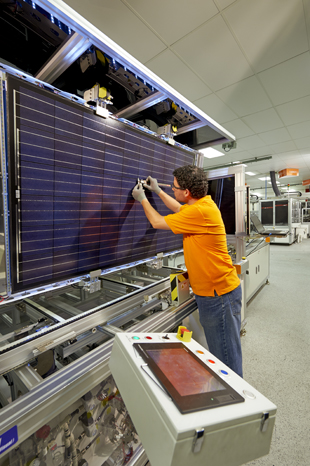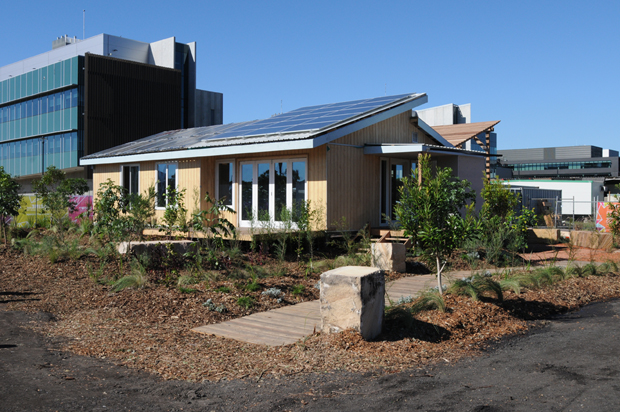Solar energy has been going through a tumultuous time of late. Aggressive price reductions largely by Chinese manufacturers have stressed many solar cell factories to the point of closure. Residential end users have benefitted from the most affordable photovoltaic panels the industry has ever seen. As a result, government incentive programs have been swamped beyond their originally intended capacity, with many forced to come to a sudden conclusion, upsetting homeowners, installers and energy utilities alike.
Indeed authors of the Pitt&Sherry Carbon Emissions Index (CEDEX) commented that coal market share of eastern Australia's electricity generation network fell below 75 per cent for "the first time in Australian history". Further concluding that, "The rapid spread of photovoltaics probably counted for about a quarter of the overall drop in power [demand]." Time then for a quick whip around of the current state of play.
One Million Rooftops
In 2008 Australia only had about 20,000 rooftop solar photovoltaic systems installed. As of April this year more than one million such installations were facing north upon our roofs. Clean Energy Council chief executive David Green, was obviously heartened by the milestone, even going as far as suggesting, "Solar is the Hills Hoist of the 21st Century."
He also noted that the solar industry currently employs more than 8000 Australians. The Clean Energy Regulator, which released the data, added, "More than 794,345 solar hot water and air source heat pump systems were also installed under the Renewable Energy Target."
By 2011, NSW was narrowly ahead of Queensland in rooftop solar PV installations, but after NSW dropped its generous Feed-in-Tariff the Sunshine State surged ahead to almost one third of all Australian grid connect solar installations.
However, it is South Australia that has the highest proportion of suitable dwellings upon which solar systems are mounted. But let's not get too carried away with bragging rights just yet - the Climate Commission notes that even after this massive surge of sparkling blue roofs, they produce only 1.2 per cent of Australia's electricity needs.
 Home Grown Solar
Home Grown Solar
Staying in South Australia, we should note that on 26 October 2012 Prime Minister Julia Gillard officially opened Tindo Solar, Australia's only manufacturer of solar (PV) modules. With cheaper and cheaper solar panels flooding the market from China it may seem a strange time to have established a local manufacturing business, but Tindo managing director Adrian Ferraretto reckons, "My cost of labour is less than a Chinese factory."
The plant at Mawson Lakes, Adelaide is said to be capable of making a new panel in less than three minutes, or roughly 240,000 panels per annum. A wholly Australian owned business, Tindo borrows its name from Kaurna Warra Aboriginal language word for sun. Tindo's panels come with individual built-in micro-inverters generating 240V Alternating Current (AC) power. Each panel is individually controlled and not affected by its neighbour.
Traditional photovoltaic panels are Direct Current (DC) and wired together in "strings", with output being dragged down by the lowest performing panel in each string before being converted via an AC inverter for feed into the 'grid'. Tindo's research suggests its AC modules generate 10 to 15 per cent more electricity than conventional systems of the same power rating.
Energy Olympics
When the Prime Minister is not opening solar plants she is sending video encouragement to 30 students at the University of Wollongong and TAFE Illawarra from NSW's South Coast. Known as Team UOW, they comprise the first Australian team to take part in the prestigious Solar De-cathlon competition.
Now in its 10th year, it was previously held in the USA and Europe, the so-called "Energy Olympics" moves to Asia for the first time - to Datong, China, 300 km west of Beijing. In August 2013, 33 universities merge into 23 teams from 13 countries and will compete in 10 events around the issue of green housing, such as market appeal, solar application, thermal comfort and hot water. Not content with being the first Aussies to go before the judges, the US Department of Energy and the National Energy Administration China, Team UOW have raised the bar by being the first crew to enter a retrofit to an existing home - a 60's fibro house to boot.
They reckon their 'Illawarra Flame' house has been transformed into a net zero-energy home. The University of Wollongong's Sustainable Building Research Centre (SBRC) has lent its support to the project, which has already engaged the students for more than two years.
 The Illawarra Flame House.
The Illawarra Flame House.
Nothing Up Front
Sungevity was co-founded by Danny Kennedy who, although American by birth, spent his formative years in Australia learning his environmental activist craft with the Australian Conservation Foundation and Greenpeace. In 2007 he morphed into a businessman, teaming up with Alec Guettel and Andrew Birch, whose background includes a Masters in Photovoltaics from University of New South Wales (UNSW) and a stint as Business Development Manager for BP Solar.
Together the three formed Sungevity, which developed Solar Lease in 2010, allowing homeowners to invest in grid-connected PV systems for $0 down. Sungevity handles all the installation and maintenance of the array, in turn charging residents a leasing fee, which mostly works out less than their electricity bills. Moving its finance model from the USA to other markets like the Netherlands and Australia has proven a challenge, but has not dampened the aim: "To put solar on every roof in Australia."
Breaking Barriers
It may be considered unusual for lightning to strike the same place twice, but Professor Stuart Wenham from the School of Photovoltaics and Renewable Energy Engineering at UNSW certainly scores repeat hits. Working with Professor Martin Green, he helped pioneer photovoltaic technology so advanced it held the world efficiency record for converting sunlight into electricity for more than a decade.
Not resting on his laurels, Wenham announced in May 2013 that his team have developed an innovative method to dramatically improve the quality of low-grade silicon, promising to significantly improve electrical efficiency and reduce the cost of solar panels.
Quoted in a UNSW media release, Wenham observed that standard commercial silicon cells currently have a maximum efficiency of around 19 per cent. The new technique, patented by UNSW researchers earlier this year, is expected to produce efficiencies between 21 and 23 per cent. They achieve this breakthrough by controlling hydrogen atoms to correct deficiencies in silicon, the most expensive component of solar cells.
 Professor Stuart Wenham.
Professor Stuart Wenham.
Community Power
Australia's first community-owned wind farm was Hepburn Wind near Daylesford, Victoria. The nation's first community-owned solar farm might also be in Victoria, if David Robinson, convenor of Locals Into Victoria's Environment (LIVE), has any say in the matter.
Owners of the vast roof space of the South Melbourne Market, the City of Port Phillip, have already bunged 136 PV panels up there. Robinson is, however, rallying support for the installation of at least 1000 solar panels on the roof, with the intent that members of the local community would invest in the panels for financial reward.
If Hepburn Springs and Daylesford, with a combined population of 5500 can raise $13.5 million to build their wind farm, LIVE reckons Port Phillip's 94,000 residents can surely raise the $1 million needed to get Community Power off the ground. Farming the Sun is seeking to establish community solar in Northern NSW and Canberra Clean Energy Connection has a similar vision for the ACT. All no doubt wishing to emulate Westmill Solar Co-operative - the world's largest community-owned solar power station in the UK - with 21,000 panels generating enough electricity to power 1400 homes.
 The South Melbourne Market.
The South Melbourne Market.
Don't Let The Sun Go Down On Me
Lastly, Dyesol have secured $4 million worth of funding towards the commercialisation of its dye-sensitised Solar Cells (DSSC).
The market turmoil of the past couple of years in the solar industry has forced it to increase its commercial efficiency up from the current eight per cent to 10 per cent, to compete with the failing prices of crystalline silicone cells.
Taxpayers handed over $2.3 million as part of the Emerging Renewables Program to BlueScope Steel for its development of a prototype building-integrated photovoltaic (BIPV) system, which was originally due for an unveiling this year.
The Australian Solar Cooling Interest Group want to see hospitals, hotels, shopping centres and recreational facilities using the sun's heat to drive desiccant and other cooling technologies for air conditioning energy savings of around 25 per cent.

